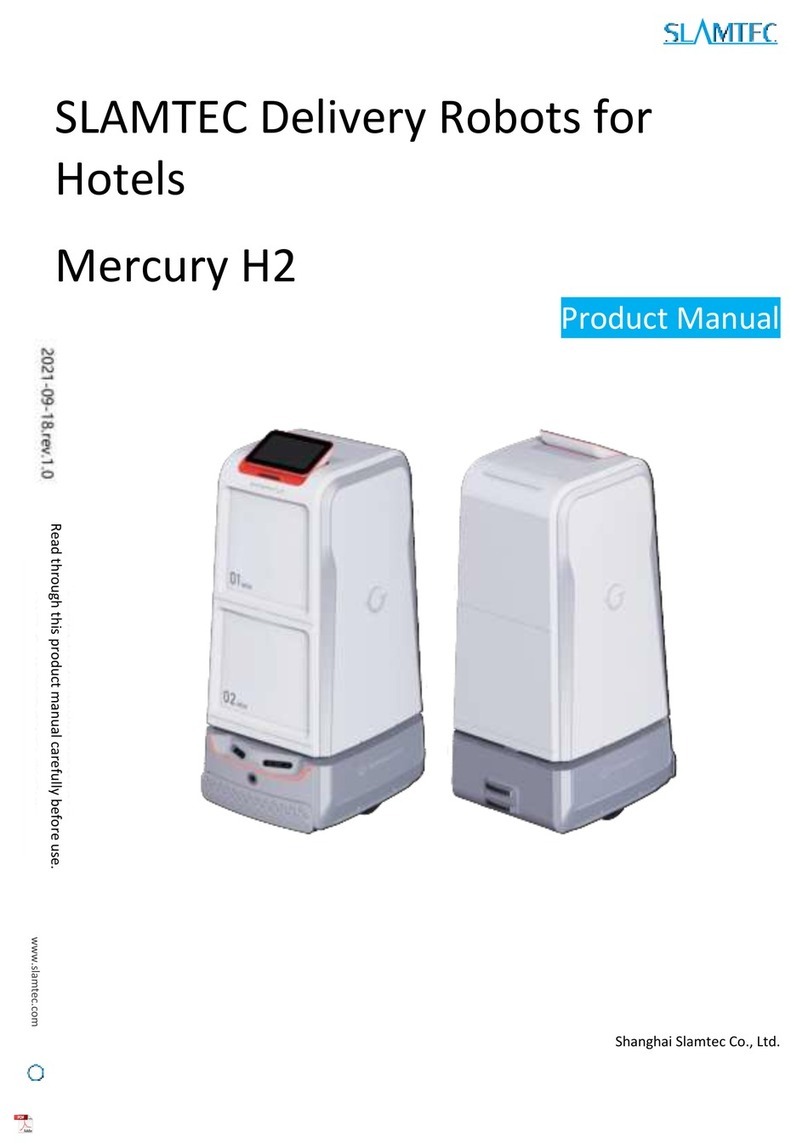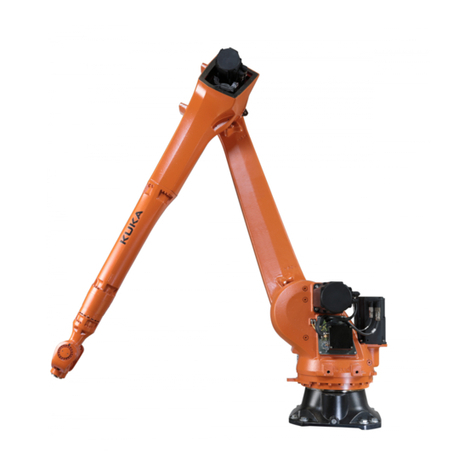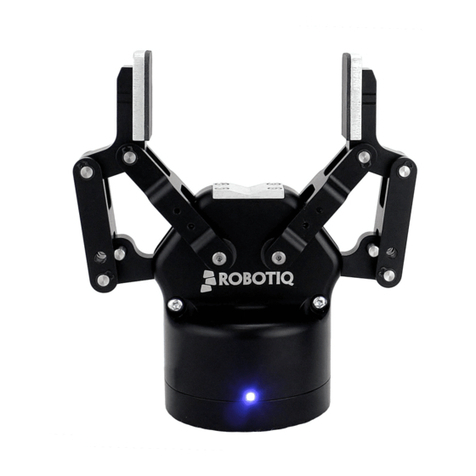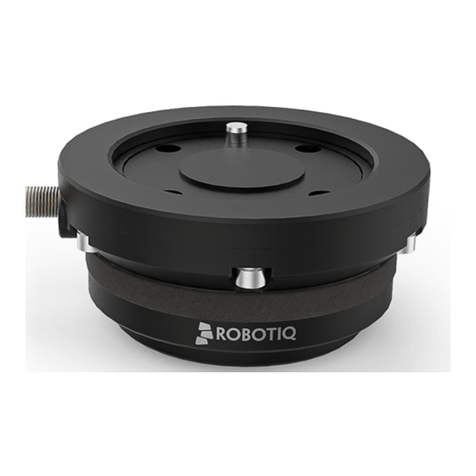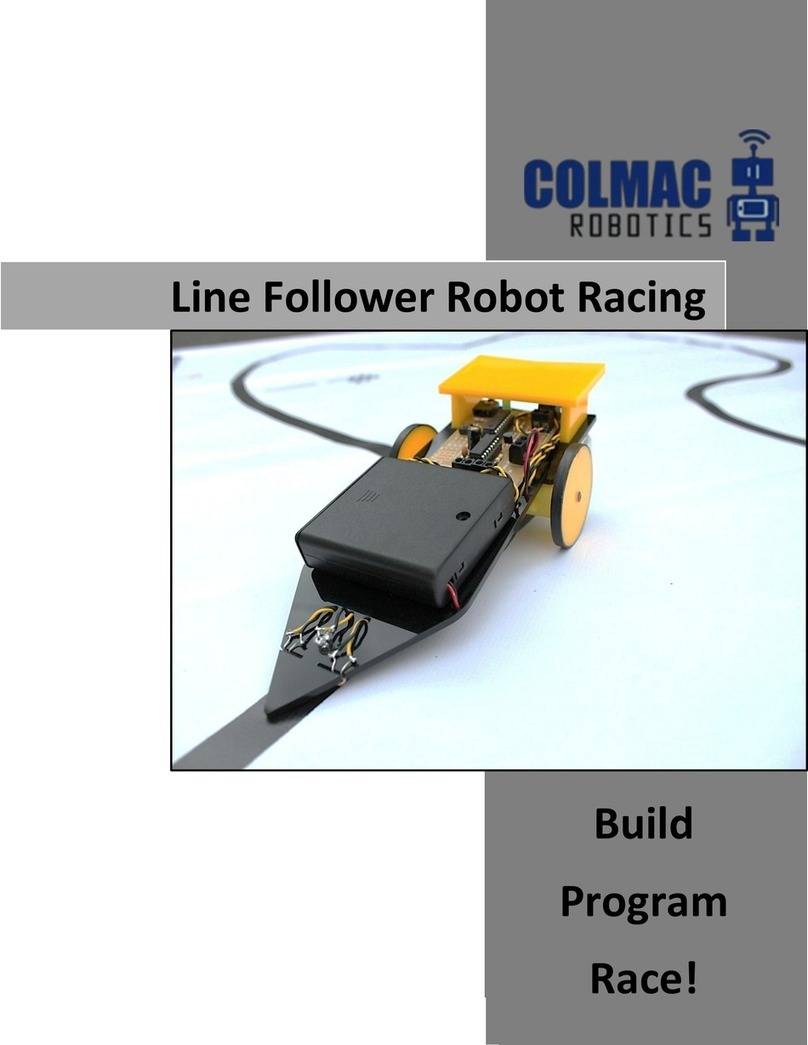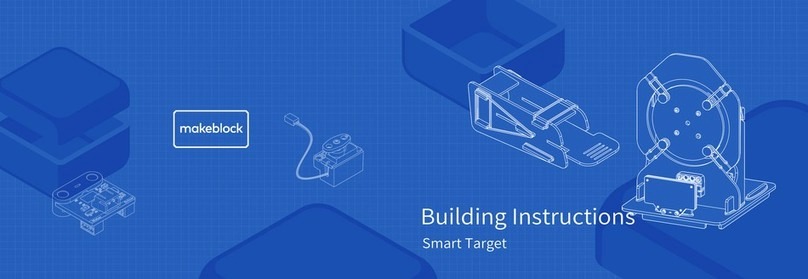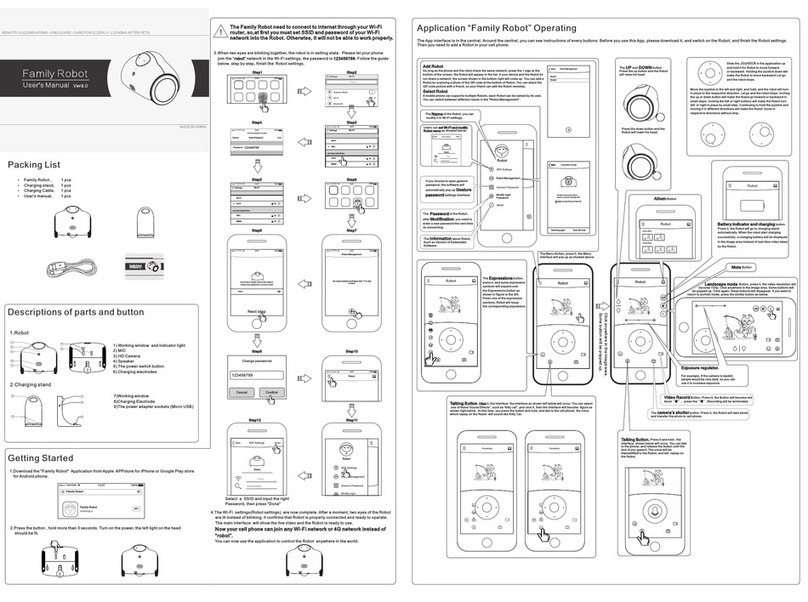Slamtec APOLLO A4M31 User manual

1/ 22
Copyright (c) 2016-2017 Shanghai Slamtec Co., Ltd.
www .slam tec.com
ShanghaiSlam tec.C o.,L td
APOLLO
General Purpose Robot Platform Standard Version
User manual
Model: A4M31
2020-07-17.rev.1.1

2/ 22
Copyright (c) 2016-2017 Shanghai Slamtec Co., Ltd.
CONTENTS ...................................................................................................................................................2
OVERVIEW ...................................................................................................................................................3
INTRODUCTION...................................................................................................................................................3
BASIC FUNCTION................................................................................................................................................3
INTERIOR MODULE BLOCK DIAGRAM ................................................................................................................3
SENSORS............................................................................................................................................................. 4
INTERFACES.........................................................................................................................................................4
CHARGING STATION........................................................................................................................................... 5
PRODUCT PACKING LIST.....................................................................................................................................6
EXTENDED PLATFORM.............................................................................................................................7
INTRODUCTION...................................................................................................................................................7
PORT DEFINITION...............................................................................................................................................7
APOLLO REFERENCE DESIGN ............................................................................................................................10
DEPLOYMENT AND USAGE ...................................................................................................................11
APOLLO DEPLOYMENT .....................................................................................................................................11
CONNECT TO COMPUTER.................................................................................................................................16
DEBUG TOOLS ..................................................................................................................................................16
CHARGING AND BATTERY.................................................................................................................................17
ATTENTION ...............................................................................................................................................20
MECHANICAL DIMENSIONS .................................................................................................................21
APPENDIX ..................................................................................................................................................22
IMAGE AND TABLE INDEX..................................................................................................................................22
Contents

3/ 22
Copyright (c) 2016-2017 Shanghai Slamtec Co., Ltd.
Introduction
Apollo is a medium-sized general purpose robot development platform
developed by SLAMTEC to meet the requirement of medium-size robot
application like reception robot, shop guiding robot and etc. Its build-in
SLAMWARE Cube autonomous localization and navigation module is designed to
realize path finding and navigation. And different applications can be integrated
with Apollo to make it work in varies business places. Apollo is equiped with
RPlidar, ultrasonic sensors, cliff sensors, bumpers, magnetic sensors, depth
cameras and etc., which helps Apollo walk freely and respond well in complicated
business environments.
Basic Function
Autonomous Mapping for Localization and Navigation
The function of Apollo platform is to realize autonomous map building,
localization and navigation. There is no need for human assisstance during its
working process. It can find the proper path to a specified place by itself and move
there freely. And it also supports multi-line patrol mode like a security guard.
Autonomous Recharging
We provide open source interface for users and developpers to use it for their
own upper application on Apollo, which can realize the recharging feature of
Apollo, namely, the ability to go back to the charge station to charge itself when
it has a very low battery.
Third Party Application Development
The Apollo has a totally free platform both in software and hardware and we offer
technical support for external extended hardware. Our users can focus on the
developing of business logic appplication via SLAMWARE SDK.
Interior Module Block Diagram
The followig figure describes the communication between Apollo and external
system, the connection of power supply and emergency stop.
Overview

4/ 22
Copyright (c) 2016-2017 Shanghai Slamtec Co., Ltd.
Figure 1-1 Connection between Apollo and External System
Sensors
Figure 2-1 Apollo Sensor Configuration
Interfaces
User
External
system
Apollo
Host system
Wired network/WIFI
User power supply port
User control port
WIFI
Charging
port
Cliff sensor
Depth Camera
RPlidar (layer)
Ultrasonic sensor
Bumper
Magnetic sensor

5/ 22
Copyright (c) 2016-2017 Shanghai Slamtec Co., Ltd.
Figure 2-2 Apollo Interfaces Configuration
Charging Station
Figure 2-3 Apollo Charger
Emergency charging port
Wi-Fi antenna
Autonomous charging port
Air switch

6/ 22
Copyright (c) 2016-2017 Shanghai Slamtec Co., Ltd.
Product Packing List
Item Name
Quantity
Remark
Apollo
1
Apollo platform
Wi-Fi antenna
2
Come with Apollo as accessories and need to be
installed on Apollo.
Depth camera and its
mounting structure
1
Come with Apollo as accessories and need to be
installed on Apollo.
Charging station
1
Come with Apollo and need to choose a proper place
before using it.
Power cable of
charging station
1
Come with charging station as accessories. Please
connect the charging station and 220V power with the
power cable.
Emergencing charging
cable of charging
station
1
Come with charging station as accessories. Please
connect the charging station and Apollo with the
charging cable.

7/ 22
Copyright (c) 2016-2017 Shanghai Slamtec Co., Ltd.
Introduction
As shown in the following figure, the extended platform of Apollo is a rounded
table with 220mm in radius. The whole top surface is all-steel and is processed
by black phosphating solution. There are five M6 threaded holes regularly
distributed on the table, which can meet various requirements of fixing the upper
module on the Apollo. Please refer to the following figure for the specific position
of threaded holes and the port dimensions.
Figure 3-1 Apollo Extended Platform
Port Definition
Figure 3-2 Interface Definition of Apollo Extended Platform
Extended Platform
User power port
Ethernet port
Control port
Threaded holes M6*5
Power port model:
WS16K2Z WEIPU 2Pin Aerial
Socket
Control port model:
D-SUB 15P Female
Connector
Ethernet port model:
Standard RJ45

8/ 22
Copyright (c) 2016-2017 Shanghai Slamtec Co., Ltd.
Pin Definition of Control Port
Figure 3-3 Pin Definition of Apollo Extended Platform Control Port
Name
Parameter
Description
Note
Ethernet port
1000/100/10Mbps
Used for communication
between users and
Apollo.
IP Address 192.168.11.1 ~
192.168.11.100 are reserved for the
bases of Apollo. Therefore, when
using this Ethernet port, please
ensure that the IP address of the
device connected to Apollo not uses
the above IP address. Or IP conflict
may occur. Please refer to the
SLAMWARE SDK for detailed
communication protocols.
Power port
DC 18-25.2V 5A
Max
Used for providing
power supply for the
device of users.
The end marked as 1 is positive while
2 is negative.
Control
port
DB-15
Self-defined 15 pin port.
User can design this
port according to their
own needs.
Please refer to the following figure for
control port definition and pin
definition, and the supported switch
type for the reference design of the
control port.
Emergency
charging port
25.2V 10A
Used for charging
Apollo under
unexpected situations
such as the charger
electrode not working.
Network resetting button
Reserved
GND

9/ 22
Copyright (c) 2016-2017 Shanghai Slamtec Co., Ltd.
Supported Switch Type and Description of Control Port
Figure 3-4 Supported Switch Type of Apollo Extended Platform Control Port
Switch Name
Description
Note
Emergency stop
switch
(Pin5 & Pin8)
Used for controling Apollo in
emergencies. Apollo will stop
moving immediately after
pressing this switch.
This switch is a must to design,
or Apollo will refuse to work.
Release switch
(Pin6 & Pin7)
Corresponded with the
emergency stop switch, after
pressing down the emergency
stop switch, user needs to press
the release switch to recover
Apollo to normal status and
continue other operations
System switch
(Pin2 & Pin12)
This switch is the power switch
for the whole system. Short press
for power-on and long press for
power-off.
Checking method
Internal pull-up to check the
time width of the low level.
Open time:
50ms~3000ms(Typical value is
300ms, and it is invalid to
repeat this operation if it has
already been in open status.)
Close time:
3000ms~15000ms( Typical
value is 4000ms, and it is
invalid to repeat this operation
if it has already been in open
status.)
Network resetting
switch(Pin3 &
Pin14)
This switch is used to reset the
wireless network.
When the network is
abonormal, please long press
the network resetting button
for 3 seconds to reset Wi-Fi.

10 / 22
Copyright (c) 2016-2017 Shanghai Slamtec Co., Ltd.
Apollo Reference Design
Figure 3-5 Apollo Reference Design
Keep enough space
for user control
port
Keep enough space for WIFI antenna
Custom Design Reference
Threaded holes M6*5
Plastic
Metal
Depth Camera Module
Floor
Depth Camera Module
The depth camera module should
be designed on the surface of the
robot as an exposed part.
Upper Module Fixing Design
Reference
There are five M6 threaded holes
regularly distributed on the top
user board for user to design and
fix the upper system and
structure.

11 / 22
Copyright (c) 2016-2017 Shanghai Slamtec Co., Ltd.
Apollo Deployment
1. Place Charger
With the charger, Apollo can recharge itself automaticallty. Therefore, the charger
requires to be put properly to ensure its performance. When Apollo goes back to
the charger, it will have a driving force, so it’s better to put the charger back against
a wall. And the wall should meet the following requirements.
a. The charger should fit the wall closely and there is no obstacles between
them. The wall with skirting line is not recommended.
b. The wall should not be made of transparent material like mirror or glass.
c. The wall should be at least three times the width of the charger.
d. The wall should be a straight wall instead of a curved one.
The charger requires a 220V power supply and its external power supply wire is
1.5m in length. So it’s better that there is a power port on the wall for the
charger(the power board is not recommended since it may cause danger due to
massy wires).
The ground in front of the charger should meet the following requirements:
a. Open. There is no obstacles in front of the charger ( with the charger as the
center and within a radius of 2 meters from the center).
b. Level. There is no slope on the ground.
c. There is no soft carpet on the ground which leads Apollo sinking into it
more that 2cm.
Please always launch Apollo from the charger to ensure that it can recharge itself
properly.
Note: if the charger is moved to a different place when using Apollo, user should
reset the charger position accordingly when loading the map. Please refer to the
detailed interfaces description in our SDK document.
2. Launch Apollo
As shown in the following figure, find the air switch and turn it on, then press the
system switch on the demo module to start the system. Once succeeded, the
system indicator turns red and the buzzer beeps several times. It takes one
minute to start the system.
Deployment and Usage

12 / 22
Copyright (c) 2016-2017 Shanghai Slamtec Co., Ltd.
Figure 4-1 Apollo Air Switch and System Switch
3. Build and Save Map
Download and install the robot graphical tool RoboStudio from our official website
http://www.slamtec.com/cn/RoboStudio. Register and login to the tool. By clicking
File->Robots in the menu, user can find a docked window opened in the left side
of the pane as in Figure 4-2. In this window, user can connect to or disconnect
from robots.
Figure 4-2 RoboStudio Robot Interface
System switch
Air switch
Network resetting switch
Release switch
Emergency
stop switch

13 / 22
Copyright (c) 2016-2017 Shanghai Slamtec Co., Ltd.
Right click the whitespace of the robot list -> choose manual connect robot in
the prompt dialog box, -> enter the IP address and port number in the new dialog
box -> click Connect to connect to the robot as shown in the following screenshot.
If you have already connected to the SSID obtained in step 3 via network adapter
on computer, please enter the default IP address 192.168.11.1 in the above dialog
box. (The IP address of your wireless adapter network should be DHCP mode)
Figure 4-3 RoboStudio Robot Connection Dialog Box
Once connected successfully, the major work area will show the robot, map
information and its status. The robot name will turn to green and the robot status
will turn to Connected as below.
Figure 4-4 RoboStudio Robot Connection
Right click a point in the place where you want to build a map, and Apollo will
follow the point to build map. After mapping, add virtual walls to the places where

14 / 22
Copyright (c) 2016-2017 Shanghai Slamtec Co., Ltd.
you want to isolate them from robot. Click File->MapEditor and choose saving
the map file to local or uploading it to the firmware.
Figure 4-5 RoboStudio Robot Map Editing Window
4. Launch Host Computer and Load the Map
The following code shows how to finish loading specified map by using SDK on
the upper computer.
1. /*
2. * upload map file to apollo
3. */
4. #include <iostream>
5. #include <rpos\robot_platforms\slamware_core_platform.h>
6. #include <rpos\robot_platforms\objects\composite_map_reader.h>
7. #include <rpos\core\pose.h>
8.
9. using namespace std;
10.
11. int main()
12. {
13. try
14. {
15. string map_path = ".\\map.stcm"; //the path of map
16. string apollo_ip = "192.168.11.1"; //the ip of apollo
17. int apollo_port = 1445; //the port of apollo ,default is 1445
18.
19. rpos::robot_platforms::SlamwareCorePlatform apollo =
20. rpos::robot_platforms::SlamwareCorePlatform::connect(apollo_ip, apollo_port);
21. //connect to the apollo
22. rpos::robot_platforms::objects::CompositeMapReader cmapreader;
23. //map reader
24. rpos::core::Pose apollo_pose = rpos::core::Pose(rpos::core::Location(0, 0, 0));
25. //the Apollo pose in map(apollo_pose should be the apollo's real pose in new map)
26. //using apollo.getpose() to get the old apollo pose
27. auto map = cmapreader.loadFile(map_path);

15 / 22
Copyright (c) 2016-2017 Shanghai Slamtec Co., Ltd.
28. //load map
29. apollo.setCompositeMap(*map, apollo_pose);
30. //set compositemap
31. rpos::core::Pose home_pose = rpos::core::Pose(rpos::core::Location(0, 0, 0));
32. //the home pose in map(home_pose should be the home's real pose in new map)
33. //using apollo.gethomepose() to get the old home pose
34. apollo.setHomePose(home_pose);
35. //set home pose
36. }
37. catch (rpos::robot_platforms::ConnectionFailException &e)
38. {
39. cout << "connect failed on " << e.what() << endl;
40. }
41. catch (rpos::system::detail::ExceptionBase &e)
42. {
43. cout << "failed on " << e.what() << endl;
44. }
45.
46. return 0;
47. }
Please refer to our SDK reference for more movement deployment.

16 / 22
Copyright (c) 2016-2017 Shanghai Slamtec Co., Ltd.
Connect to Computer
Wired Connection
According to the requirements from actual application development, we have
designed a RJ45 Ethernet port on the extended platform of Apollo. Therefore, user
can directly connect Apollo to PC via network cable for extension or further
development.
Wireless Connection
To help our user test Apollo and meet the requirements in future actual
application scenarios, Apollo also supports wireless connection. User can connect
to the SSID of Apollo with a computer and then connect to Apollo with its default
IP address 192.168.11.1. In addition, user can use our Web Portal tool to distribute
a specific IP address for Apollo and use it for connection.
Debug Tools
RoboStudio
RoboStudio graphical tool is used for testing and controlling Apollo. Please
download it from our official website as below:
http://www.slamtec.com/cn/RoboStudio
In the same page, we also provide a document to introduce the usage of this tool.
Web Portal Tool
During developing, testing and controlling the SLAMTEC robtots like Apollo, our
users can do many things to our robot via the Web Portal tool, such as checking
basic information,upgrading firmware and configuring WiFi. (Default username:
admin
. Default password:
admin111
)
Our Web Portal currently supports the following features:
1. Check the information of the robot;
2. Restart the SLAMWARE module;
3. Upgrade firmware
Slamtec provides Apollo firmware renewal and upgrade regularly. Our users can
upgrade firmware via the Web Portal tool. Please ask for the latest firmware from
our support engineers or sales representatives. The upgrade progress lasts for
5~10 minutes and the buzzer beeps during the upgrade process.

17 / 22
Copyright (c) 2016-2017 Shanghai Slamtec Co., Ltd.
Apollo will restart once the upgrade finished. Before that, please ensure that
Apollo has sufficient electricity.
4. WiFi configuration;
5. Start diagnosing SLAMWARE core;
6. Modify admin password;
For usage details, please refer to the following document:
https://wiki.slamtec.com/display/SD/SQ001+SLAMWARE+Web+Portal+Function
+Overview
Charging and Battery
There are two ways to charge Apollo battery.
Contact Charging
Apollo has a charger supported automatically recharging. When the battery is
lower than 30%(this value can be adjusted by the upper system according to actual
requirements), Apollo will find the charger by itself and start recharging
automatically.
Manual Charging in Emergency
In some unexpected situations, like Apollo cannot recharge itself temporarily, user
can use emergency charging cable to charge Apollo The emergency charging port
of Apollo is shown in the following figure. Please use the emergency charging
cable to connect the emergency charging port on the charger and the charging
port on Apollo
Once the fan inside the charger starts work, the charger starts charging for Apollo.
Note: there is no indicator lighting up for charging in emergency.

18 / 22
Copyright (c) 2016-2017 Shanghai Slamtec Co., Ltd.
Figure 4-6 Manual Charging Connection
Battery Attention
Charging
Do not charge Apollo or its battery with non-official charging devices.
The battery should be charged within the range pf temperature specified in the
products Specification. Stop charging immediately when the surface temperature
of the battery is over 50℃.
Before charging, please ensure the polarities of the battery are connected properly.
Reverse charging is strictly prohibited. Reverse charging cannot charge the battery.
Inversely, it will induce fatal damage to the battery and even lead to battery
heating, swelling, leaking, fire and explosion.
Storage
The battery should be stored in a cool and dry place. If you are intend to keep the
battery for a long time (3 months or longer), it is recommended that the battery
should be stored under the dry environment with temperature during 10-25℃
and without corrosive gas. And the battery should be charged at least one time
every six months to ensure the voltage of the battery is between 3.6V-3.9V.
Attentional Notes
Since the battery is softly packaged with aluminum foil, it is vulnerable to sharp
objects. Please do not place the battery with sharp objects.
Charging port
Apollo
emergency
charging port

19 / 22
Copyright (c) 2016-2017 Shanghai Slamtec Co., Ltd.
Do not fall, hit or bend the battery or it may lead to fire.
Do not disassemble the battery in any circumstances or it may cause internal
short-circuit that results in swelling and fire.
Do not directly connect the positive and negative anodes of the battery or it may
lead to fatal damage to the battery and even fire.
Do not put the battery into fire or it may cause danger.
Do not put battery into liquid, such as water.
Do not charge the battery in a car.
Avoid violent vibration, shock and pressing during the transportation of the
battery and handle it gently when carrying it. The battery should be packaged and
protected with soft packing material.

20 / 22
Copyright (c) 2016-2017 Shanghai Slamtec Co., Ltd.
Handle Apollo base gently(do not kick, thrust or drag Apollo).
Do not spill any liquid on Apollo.
Do not use the recharging function of Apollo when it is walking on a soft carpet
which can sag more than 2cm.
Ensure that Apollo always starts on its charger.
Do not change or replace anything in the machine without autiorization.
Ensure that the load of Apollo meets the requirement of the specification.
Do not use Apollo on slope.
Do not use Apollo under environment with too many highly transparent
materials.
Attention
Table of contents
Other Slamtec Robotics manuals
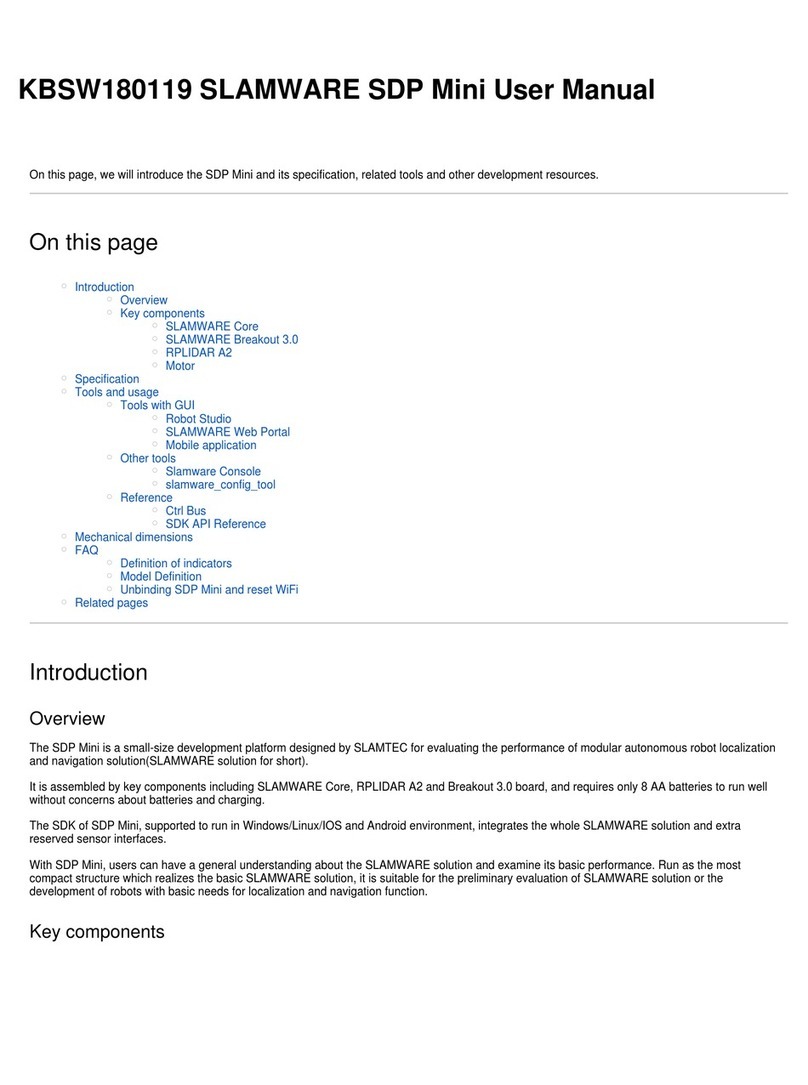
Slamtec
Slamtec SDP Mini User manual

Slamtec
Slamtec SDP Mini User manual
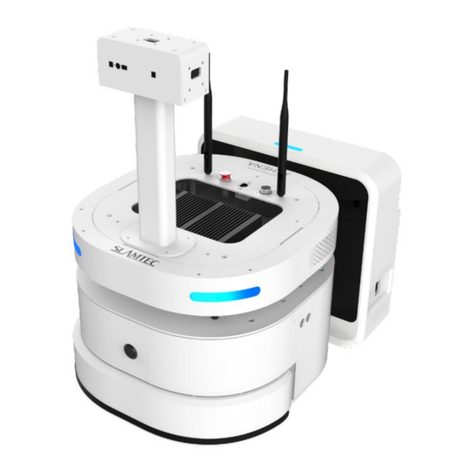
Slamtec
Slamtec ATHENA N4M11 User manual
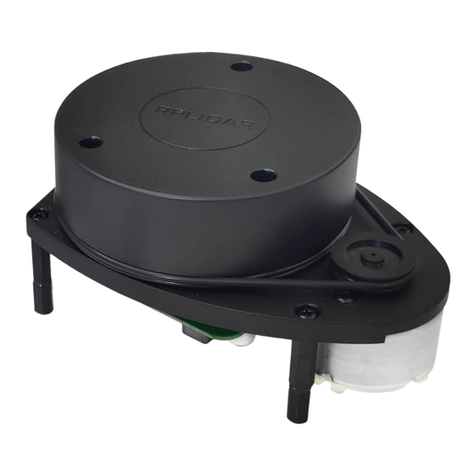
Slamtec
Slamtec RPLIDAR A1 User manual
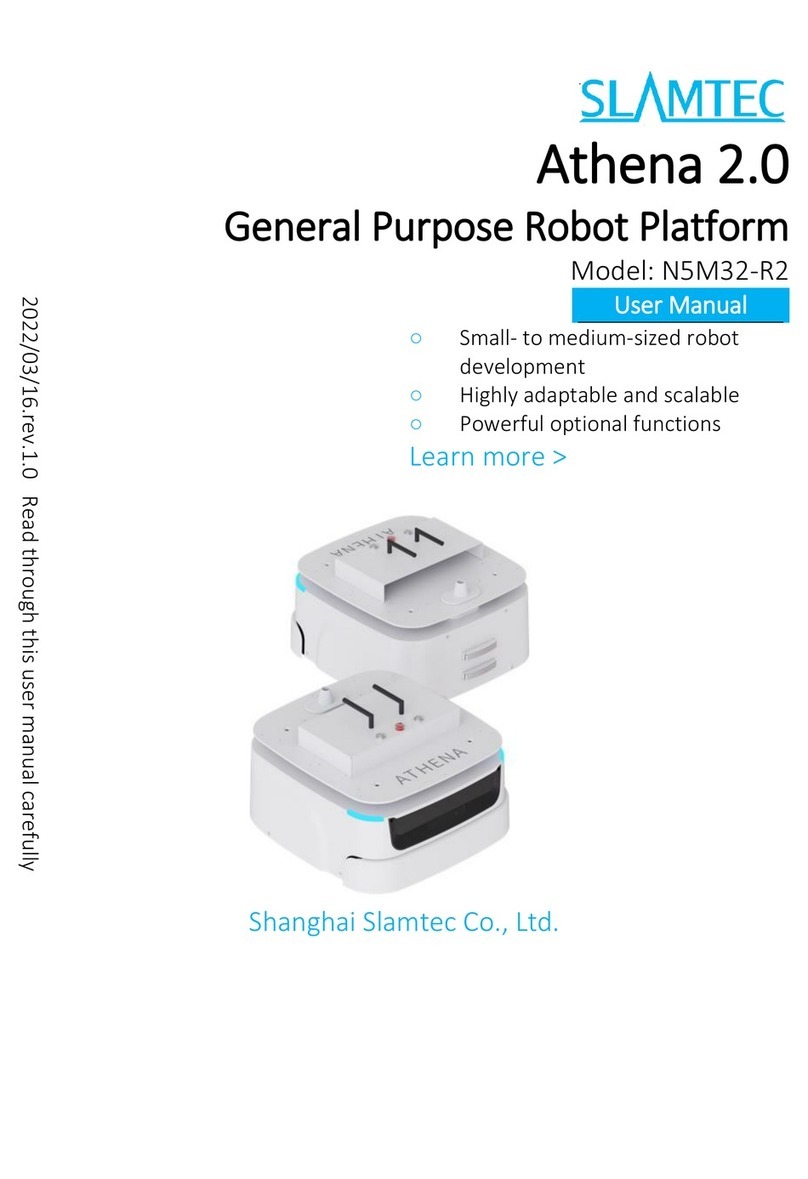
Slamtec
Slamtec N5M32-R2 User manual
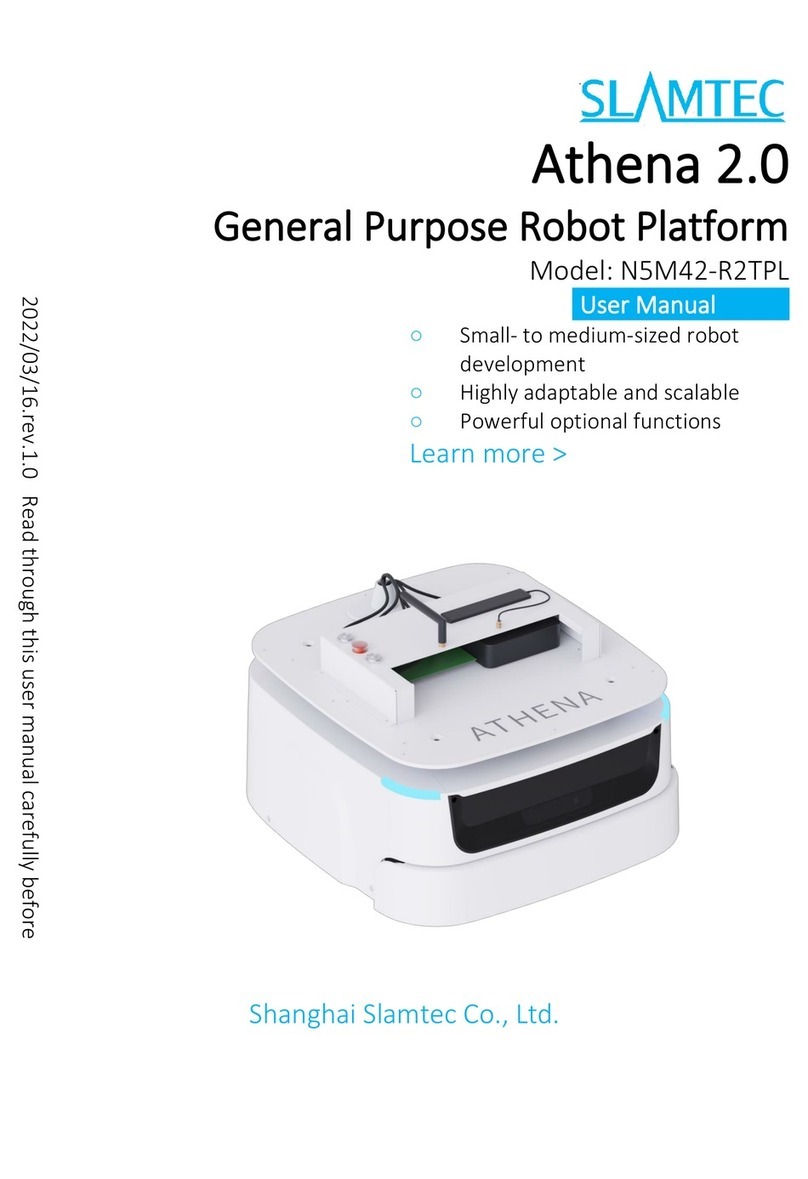
Slamtec
Slamtec Athena 2.0 User manual
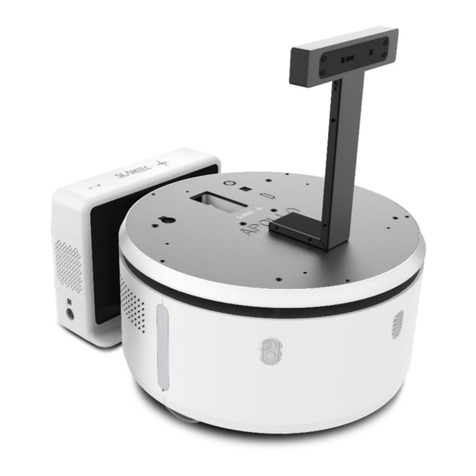
Slamtec
Slamtec APOLLO User manual
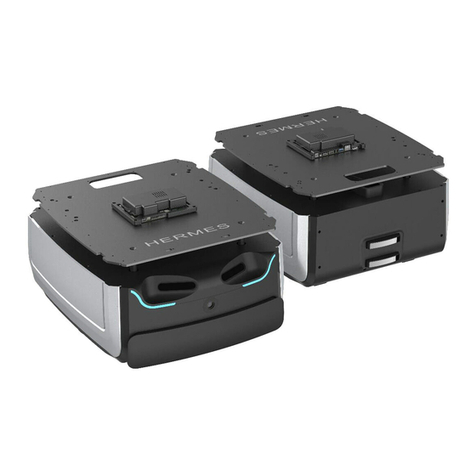
Slamtec
Slamtec Hermes User manual
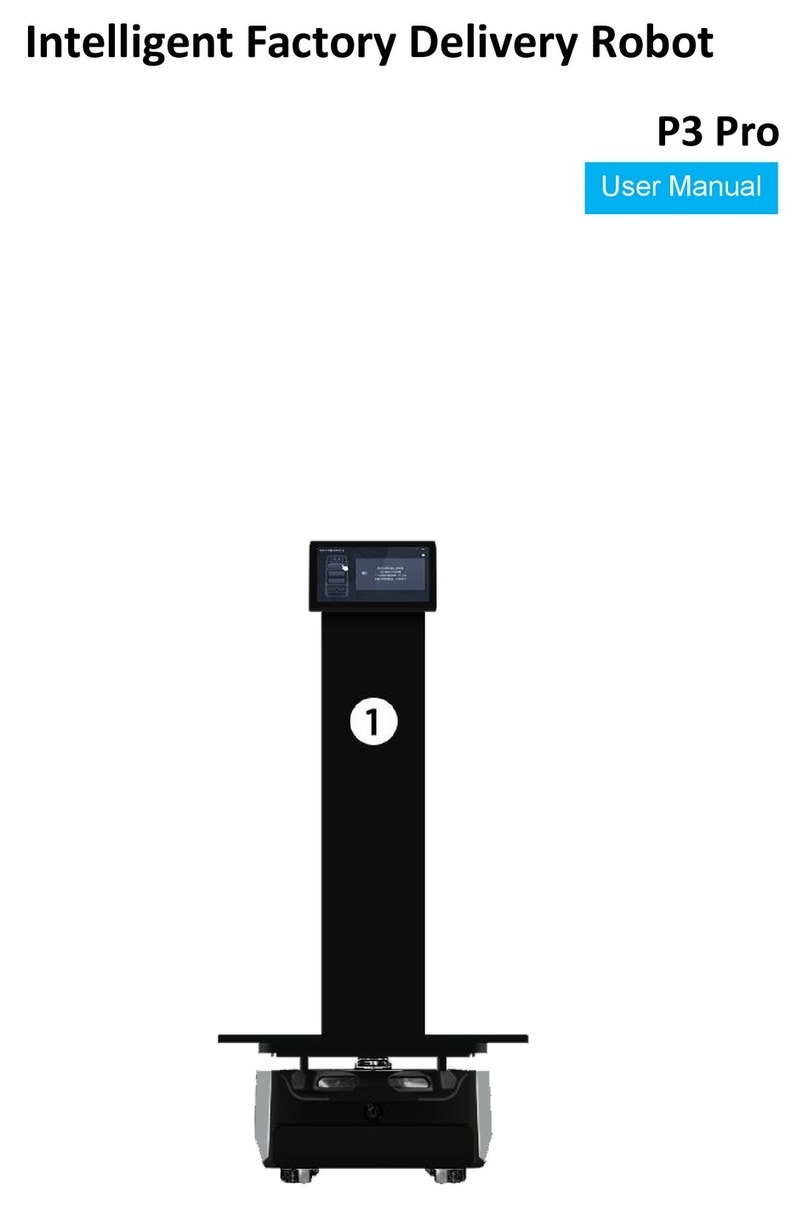
Slamtec
Slamtec P3Pro User manual
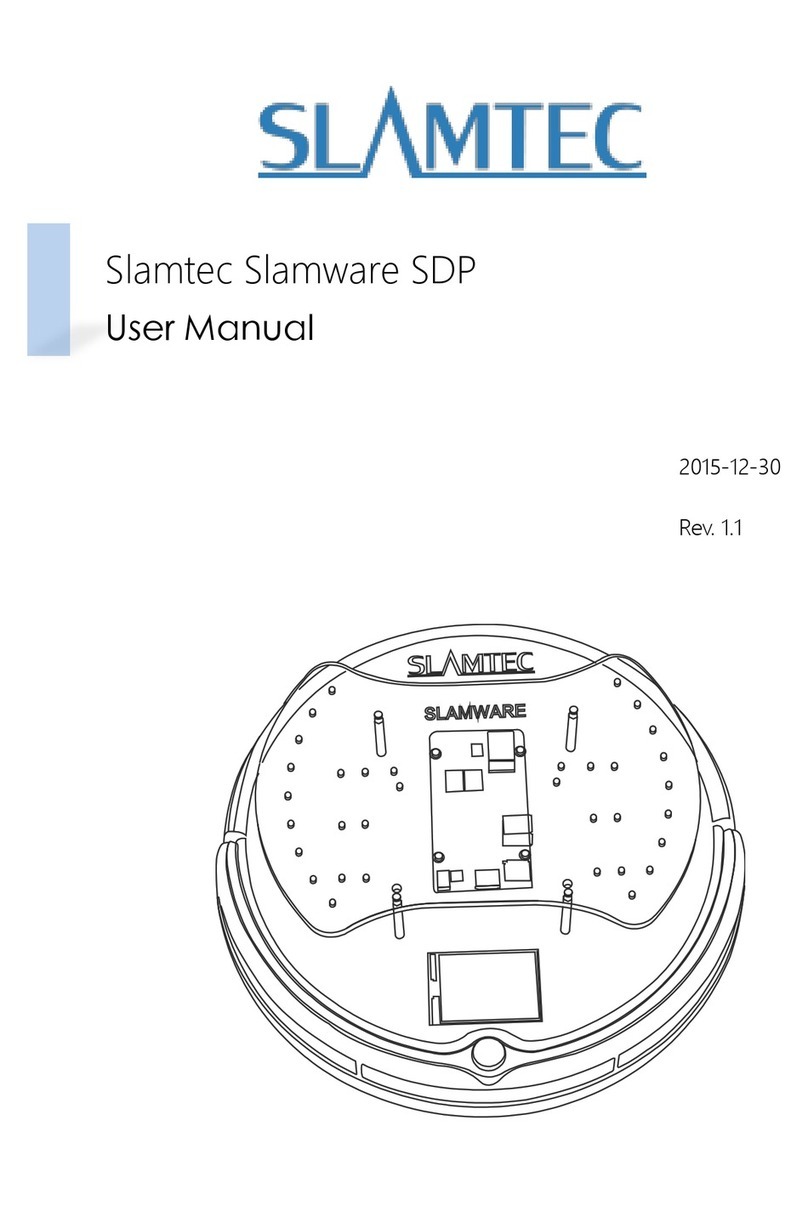
Slamtec
Slamtec Slamware SDP User manual
Popular Robotics manuals by other brands

Mitsubishi Electric
Mitsubishi Electric MELFA RH-6SQH Series instruction manual

CIC
CIC Frilled Lizard Assembly & instruction manual
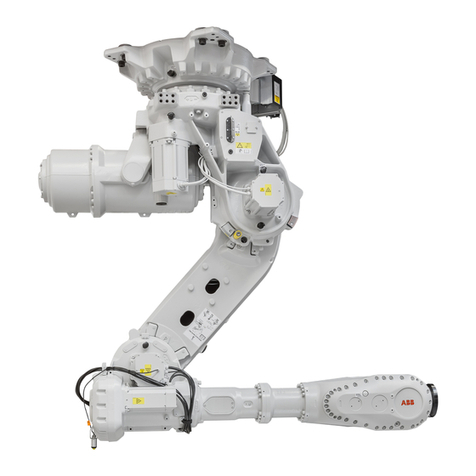
ABB
ABB IRB 6700 Series product manual

Pro's Kit
Pro's Kit AI assembly & inspection manual
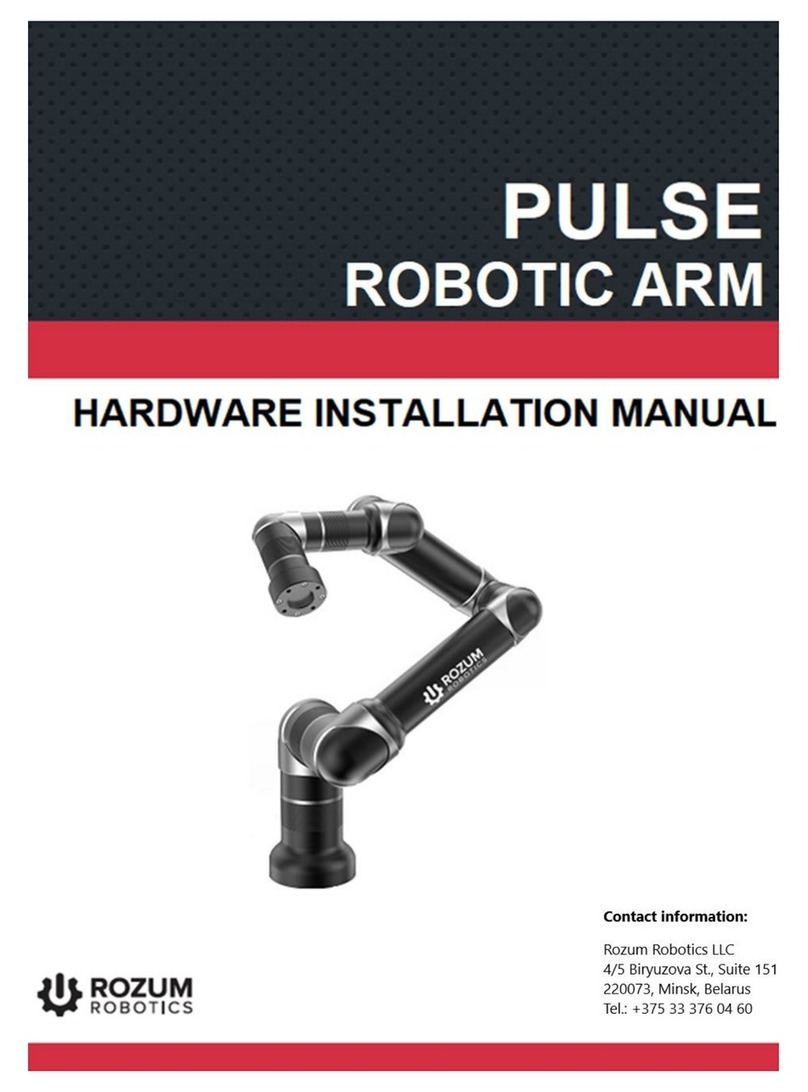
rozum robotics
rozum robotics PULSE 75 Hardware installation manual
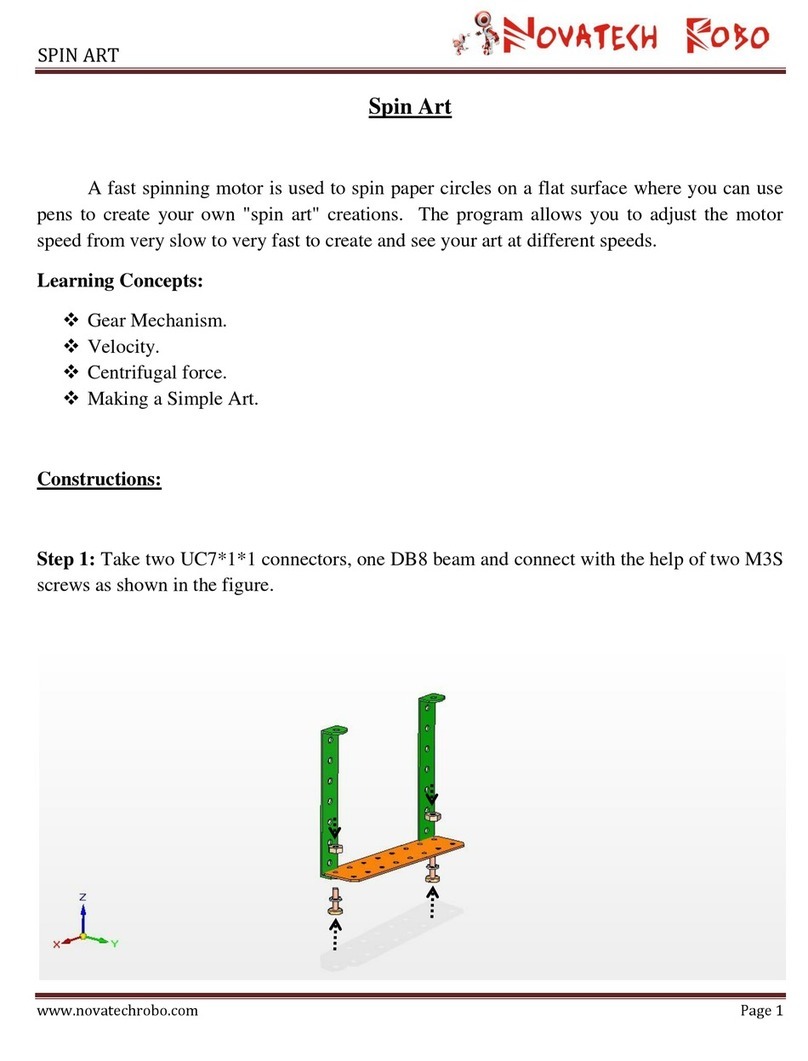
NOVATECH ROBO
NOVATECH ROBO SPIN ART manual
